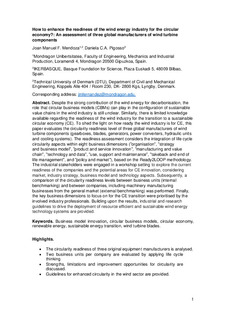Izenburua
How ready is the wind energy industry for the circular economy?Egilea (beste erakunde batekoa)
Argitalpen data
2023Argitaratzailea
ElsevierGako-hitzak
Business model innovation
Circular business models
Renewable energy
ODS 7 Energía asequible y no contaminante ... [+]
Circular business models
Renewable energy
ODS 7 Energía asequible y no contaminante ... [+]
Business model innovation
Circular business models
Renewable energy
ODS 7 Energía asequible y no contaminante
ODS 9 Industria, innovación e infraestructura
ODS 12 Producción y consumo responsables
ODS 13 Acción por el clima
Sustainable energy transition
Wind turbines
Wind turbine blades [-]
Circular business models
Renewable energy
ODS 7 Energía asequible y no contaminante
ODS 9 Industria, innovación e infraestructura
ODS 12 Producción y consumo responsables
ODS 13 Acción por el clima
Sustainable energy transition
Wind turbines
Wind turbine blades [-]
Laburpena
Despite the strong contribution of wind energy for decarbonisation, the readiness of the wind industry for the transition to a sustainable circular economy (CE) is still unclear. To support CE innovat ... [+]
Despite the strong contribution of wind energy for decarbonisation, the readiness of the wind industry for the transition to a sustainable circular economy (CE) is still unclear. To support CE innovation in the wind industry, this paper assesses the circularity readiness of six business units from three global manufacturers of wind turbine components (Siemens Gamesa Renewable Energy - gearboxes and blades, INGETEAM - generators and power converters, and HINE - hydraulic units and cooling systems). The readiness assessment was carried out in a workshop setting following the ready2LOOP methodology, covering eight business dimensions: i) Organisation; ii) Strategy and Business Model Innovation; iii) Product and Service Innovation; iv) Manufacturing and Value Chain; v) Technology and Data; vi) Use, Support and Maintenance; vii) Takeback and End-of-Life Management; and viii) Policy and Market. Subsequently, the circularity readiness profile of each business unit was analysed in relation to internal and external benchmarking (between business units and across machinery manufacturing companies, respectively). On the basis of the readiness assessment, six areas were prioritised for CE innovation within the wind industry, namely: (1) implementing circular criteria and indicators in product design and public tender processes; (2) ensuring components´ tracking and monitoring over their life cycle; (3) implementing efficient reverse logistics; (4) exploring alternative business model concepts; (5) improving recycling technologies for higher material quality outcomes; and (6) develop circular wind hubs for information and data sharing. The findings provide guidance for renewable energy policymakers, researchers, and industry stakeholders in pursuing the sustainable energy transition, through enhanced circularity performance. [-]
Argitaratzailearen bertsioa
https://doi.org/10.1016/j.spc.2023.10.016Dokumentu-mota
Preprinta
Eskubideak
© 2023 The AuthorsSarbidea
Sarbide irekiaLaburpena
Despite the strong contribution of wind energy for decarbonisation, the readiness of the wind industry for the transition to a sustainable circular economy (CE) is still unclear. To support CE innovation in the wind industry, this paper assesses the circularity readiness of six business units from three global manufacturers of wind turbine components (Siemens Gamesa Renewable Energy - gearboxes and blades, INGETEAM - generators and power converters, and HINE - hydraulic units and cooling systems). The readiness assessment was carried out in a workshop setting following the ready2LOOP methodology, covering eight business dimensions: i) Organisation; ii) Strategy and Business Model Innovation; iii) Product and Service Innovation; iv) Manufacturing and Value Chain; v) Technology and Data; vi) Use, Support and Maintenance; vii) Takeback and End-of-Life Management; and viii) Policy and Market. Subsequently, the circularity readiness profile of each business unit was analysed in relation to internal and external benchmarking (between business units and across machinery manufacturing companies, respectively). On the basis of the readiness assessment, six areas were prioritised for CE innovation within the wind industry, namely: (1) implementing circular criteria and indicators in product design and public tender processes; (2) ensuring components´ tracking and monitoring over their life cycle; (3) implementing efficient reverse logistics; (4) exploring alternative business model concepts; (5) improving recycling technologies for higher material quality outcomes; and (6) develop circular wind hubs for information and data sharing. The findings provide guidance for renewable energy policymakers, researchers, and industry stakeholders in pursuing the sustainable energy transition, through enhanced circularity performance.






















